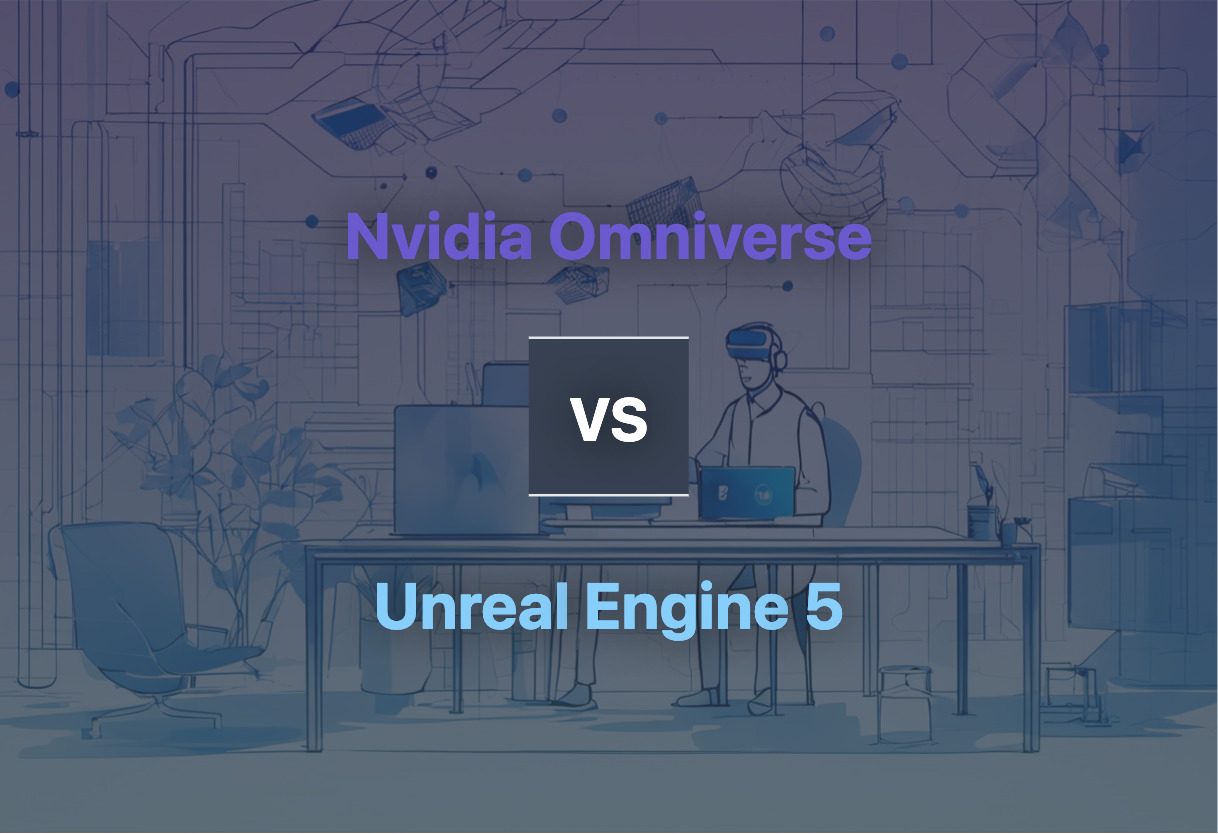Given its universal coverage, scalability and nuanced capabilities, unleashed NVIDIA Omniverse caters better for teams and high-end developers with specific demands and infrastructural support. Conversely, Unreal Engine 5, Iceberg with next-gen 3D tools is an optimal pick for a wider base, particularly suited for game developers seeking adaptivity and unprecedented detail.

Key Differences Between Nvidia Omniverse and Unreal Engine 5
- Licensing and Pricing: Omniverse offers three distinct licenses, its Enterprise license starts at $9,000 p.a. UE5 has a royalty model, charges 5% when gross exceeds $1 million.
- Use Case: Omniverse’s USD-based platform suits interconnected apps/extensions, ideal for industrial metaverse applications. UE5 is designed for detailed and dynamic game development.
- Technology: Omniverse combines Nvidia RTX technology with OpenUSD. UE5 boasts Nanite and Lumen for game realism, offering TSR and World Partition features.
- Compatibility: Omniverse optimized for Nvidia RTX-powered devices. UE5 is compatible across numerous desktop, mobile, console, VR/AR platforms
| Comparison | Nvidia Omniverse | Unreal Engine 5 |
|---|---|---|
| Core Offering | Universal Scene Description (OpenUSD)-based 3D computing platform | Real-time 3D content creation engine |
| Key Technologies | NVIDIA RTX Technology | Nanite, Lumen, Temporal Super Resolution(TSR), Control Rig, World Partition |
| Optimization | NVIDIA RTX-powered workstations and servers | High degree of portability |
| Custom Development | Developers can build Omniverse SDK-based apps, extensions and microservices | Source code available on Github, commercial use based on royalty model |
| Pricing | Standard license free, Omniverse Enterprise from $9,000 p.a. | Royalty fee of 5% of gross revenue when lifetime gross exceeds $1 million |
| Development Language | Python or C++ based extensions | C++ |
| Compatibility | Available on NVIDIA RTX Systems for on-premises and Omniverse Cloud for cloud-based solutions | Compatible with wide range of desktop, mobile, console, VR/AR platforms |
What Is Nvidia Omniverse and Who’s It For?
Nvidia Omniverse is a cutting-edge platform that harnesses the power of Universal Scene Description (OpenUSD) to redefine 3D computing. Leveraging over 20 years of Nvidia’s advancements in AI, rendering and simulation technology, it aims to revolutionize complex 3D workflows that allow individuals and teams to create and customise 3D pipelines. Whether you are an individual developer, medium-sized organization, or a large enterprise, Nvidia Omniverse provides three licensing options tailored to your needs, including Omniverse Enterprise and Omniverse Cloud services that are coming soon.

Pros of Nvidia Omniverse
- Combines NVIDIA RTX technology with USD for powerful scalability
- Transforms and optimizes complex 3D workflows
- Offers licensing options for individuals, organizations, and cloud-based solutions
- Empowers developers to monetize their solutions on Omniverse platform
Cons of Nvidia Omniverse
- Omniverse platform may have a higher price-point with enterprise licenses starting at $9,000 p.a.
- Complexity of the platform may create a learning barrier for some individual developers
What Is Unreal Engine 5 and Who’s It For?
Developed by Epic Games, Unreal Engine 5 (UE5) is a pioneering system in next-generation, real-time, 3D content creation. With a focus on creating expansive, detailed worlds, UE5’s advanced features like Nanite and Lumen are changing the game with multi-million-polygon meshes processing at real-time frame rate. The engine is ideal for avid game developers and creators who utilize large, detailed, realistic scenes. A home to countless desktop, mobile, console, and VR/AR applications.

Pros of Unreal Engine 5
- Enables creation of expansive, detailed, worlds at real-time frame rate
- Offers innovative features like Nanite, Lumen, and Control Rig
- Is compatible with a wide range of platforms
- Provides royalty free model for commercial use
Cons of Unreal Engine 5
- Royalty fee of 5% of gross revenue once lifetime gross exceeds $1 million
- High development cost with prices ranging between 35K-85K
Nvidia Omniverse vs Unreal Engine 5: Pricing
The pricing models of Nvidia Omniverse and Unreal Engine 5 appeal to a vast audience, with Omniverse offering tiered licenses and Unreal Engine 5 adopting a royalty-based model.
Nvidia Omniverse
Offering three licensing options – standard, Omniverse Enterprise, and Omniverse Cloud, Nvidia Omniverses’ pricing is categorized to cater to individuals, teams, and organizations. The standard license meant for individuals and developers is free and gives access to Omniverse for OpenUSD and 3D workflows. Omniverse Enterprise, aimed at larger organizations, is priced from $9,000 annually, comes with exclusive applications and caters for complex workflow development. The Omniverse Cloud license is purpose-built for advanced cloud-based 3D development and management. Developers can monetize their solutions created with Omniverse SDK through the Omniverse platform.
Unreal Engine 5
Unreal Engine 5 employs a royalty-based pricing model where it charges 5% of gross revenue when a project’s lifetime gross exceeds $1 million. This fee is waived for games published on the Epic Games Store. The use of Unreal Engine 5, developed by Epic Games, allows developers to create intricate real-time 3D content. The source code is available on Github for commercial use, falling under the royalty model. This makes Unreal Engine 5 a flexible and potentially cost-effective solution for independent developers, startups and large scale production houses alike.
Code Examples for Nvidia Omniverse & Unreal Engine 5
Nvidia Omniverse
Below demonstrates an Nvidia Omniverse script for creating a unique light pattern for landscapes. Ensure your NV Omniverse Open Beta is updated to the latest version for optimal execution of the code.
#include "omni/kit/cmdArg/Arg.h"
#include "omni/kitCmd/registry/ITool.h"
#include "pxr/base/tf/diagnostic.h"
int main() {
pxr::GfVec3f position(10.0f, 10.0f, 10.0f);
pxr::GfVec3f direction(-1.0f, -1.0f, -1.0f);
pxr::UsdPrim lightPrim = context.CreateLight("SpotLight", position, direction);
return 0;
}
Unreal Engine 5
Here’s a code snippet for creating an interactive door in Unreal Engine 5. Make sure to have the latest UE5 version and Visual Studio 2019 (minimum) installed.
#include "InteractiveDoor.h"
#include "Components/StaticMeshComponent.h"
AInteractiveDoor::AInteractiveDoor() {
PrimaryActorTick.bCanEverTick = true;
DoorFrame = CreateDefaultSubobject<UStaticMeshComponent>(TEXT("Door Frame"));
RootComponent = DoorFrame;
Door = CreateDefaultSubobject<UStaticMeshComponent>(TEXT("Door"));
Door->AttachToComponent(DoorFrame, FAttachmentTransformRules::KeepRelativeTransform);
}
void AInteractiveDoor::Interact() {
if (bIsOpen) {
CloseDoor();
} else {
OpenDoor();
}
}
void AInteractiveDoor::OpenDoor() {
Door->SetRelativeRotation(FRotator(0, 90, 0));
bIsOpen = true;
}
void AInteractiveDoor::CloseDoor() {
Door->SetRelativeRotation(FRotator(0, 0, 0));
bIsOpen = false;
}
So, which is the victor – Nvidia Omniverse or Unreal Engine 5?
Choosing between Nvidia Omniverse and Unreal Engine 5 can be a complex decision. Let’s dissect both competitive beasts for different audience segments.
Game Developers
For game developers, Unreal Engine 5 takes the cake. Its innovative features like Nanite, Lumen, and Control Rig provide unprecedented realism. On top of that, the royalty model makes it financially feasible. If your world revolves around creating next-gen games, UE5 is right up your alley.

Business Organizations
Is your business involved in developing advanced 3D applications & workflows? The Nvidia Omniverse with its Enterprise license provides robust tools to design interoperable workflows and manage complex metaverse applications. The fact that it is built on the OpenUSD, accessible via RTX set-ups and Cloud, makes it a solid choice for businesses.

Individual Developers and Artists
For individual developers and artists, the Nvidia Omniverse’s standard license offers a wallop. Free access to Omniverse for OpenUSD, scalable 3D workflows, and the flexibility to create SDK-based apps with Python or C++ make it a no-brainer pick for this group.

Universities and Learning Institutes
For educational institutes, the Unreal Engine 5 shines. The free availability of source code on Github, free sample projects, and a complete royalty-leeway until lifetime gross exceeds $1M makes UE5 a perfect teaching tool.

In a nutshell, if you’re creating expansive, detailed worlds for games, choose Unreal Engine 5. If you require scalable, interconnected workflows for advanced 3D applications, Nvidia Omniverse is the way to go.
Patrick Daugherty
Content writer @ Aircada. Merging AR expertise with a love for late-night gaming sessions.





